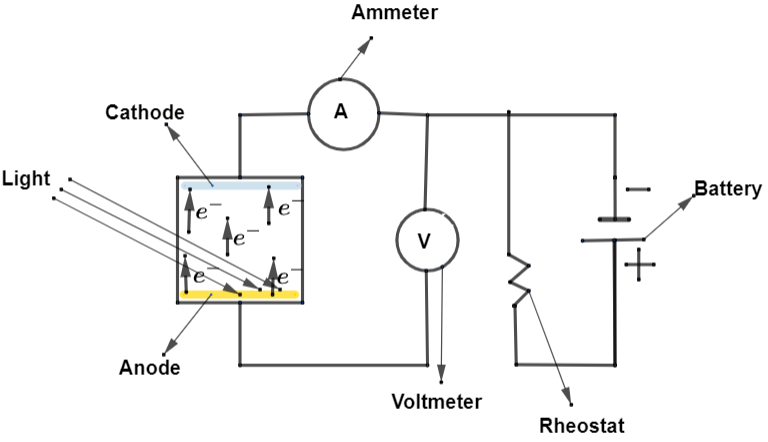
Which of the following shows the particle nature of light?
(a) Refraction
(b) Interference
(c) Polarization
(d) Photoelectric effect.
Answer
575.7k+ views
Hint: We will take the help of a diagram to get to know that the hitting of light to a surface having electrons inside them, gets loose and transfers from anode to cathode. We will also use the definition of polarization effect to get towards the right option.
Complete answer:
Electromagnetic radiation: We define electromagnetic radiation as a radiation in the form of a photon which looks like waves of an electromagnetic field.
Photoelectric effect: when the above discussed electromagnetic radiation performs the action of hitting the surface having electrons inside it then, the emission of electrons from that surface takes place. This is a phenomenon which we call the photoelectric effect. The diagram below shows the transference of electrons from anode to cathode.

So, the correct answer is “Option D”.
Additional Information:
(1) The electrons that got emitted from the surface are, hence, called photoelectrons.
(2) The characteristics of photoelectric effect are as follows:
(i) As soon as the light in a form of waves enters a surface then the process of emission takes place at a very high speed or we can say instantaneously.
(ii) If there is an increase of the intensity of the radiation then also it will not affect the kinetic energy on electrons.
(iii) In this effect we will find that there is a presence of minimum frequency below which the photoelectric effect gets nullified.
Note:
We will remember the following points to find the right option.
(1) As by the statement of the question we find that the particle nature of light is the process of emission of light in the form of waves which generates the action of electrons emitting from the surface on which the light has been drawn.
(2) The photoelectric effect consists of reflection due to which the light hits the surface instead of getting through it.
(3) Refraction is the process of passing light, which passes through the surface instead of reflecting through it.
Complete answer:
Electromagnetic radiation: We define electromagnetic radiation as a radiation in the form of a photon which looks like waves of an electromagnetic field.
Photoelectric effect: when the above discussed electromagnetic radiation performs the action of hitting the surface having electrons inside it then, the emission of electrons from that surface takes place. This is a phenomenon which we call the photoelectric effect. The diagram below shows the transference of electrons from anode to cathode.

So, the correct answer is “Option D”.
Additional Information:
(1) The electrons that got emitted from the surface are, hence, called photoelectrons.
(2) The characteristics of photoelectric effect are as follows:
(i) As soon as the light in a form of waves enters a surface then the process of emission takes place at a very high speed or we can say instantaneously.
(ii) If there is an increase of the intensity of the radiation then also it will not affect the kinetic energy on electrons.
(iii) In this effect we will find that there is a presence of minimum frequency below which the photoelectric effect gets nullified.
Note:
We will remember the following points to find the right option.
(1) As by the statement of the question we find that the particle nature of light is the process of emission of light in the form of waves which generates the action of electrons emitting from the surface on which the light has been drawn.
(2) The photoelectric effect consists of reflection due to which the light hits the surface instead of getting through it.
(3) Refraction is the process of passing light, which passes through the surface instead of reflecting through it.
Recently Updated Pages
A man running at a speed 5 ms is viewed in the side class 12 physics CBSE

The number of solutions in x in 02pi for which sqrt class 12 maths CBSE

State and explain Hardy Weinbergs Principle class 12 biology CBSE

Write any two methods of preparation of phenol Give class 12 chemistry CBSE

Which of the following statements is wrong a Amnion class 12 biology CBSE

Differentiate between action potential and resting class 12 biology CBSE

Trending doubts
What are the major means of transport Explain each class 12 social science CBSE

Which are the Top 10 Largest Countries of the World?

Draw a labelled sketch of the human eye class 12 physics CBSE

How much time does it take to bleed after eating p class 12 biology CBSE

Explain sex determination in humans with line diag class 12 biology CBSE

Explain sex determination in humans with the help of class 12 biology CBSE




